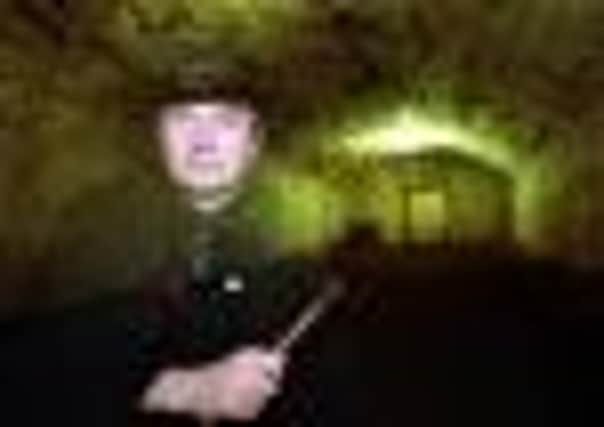Auld Reekie at Halloween: Horror stories from Edinburgh’s dark past


Half Hangit Maggie
In 1723, a fish hawker named Maggie Dickson left Edinburgh for relatives in Newcastle via Kelso after being deserted by her husband. Having only planned to stay in Kelso for a day in order to split her journey, she asked to stay longer after becoming friendly with the innkeeper, and offered her services in exchange for lodgings. This proved to be a fateful decision: after a time, she became pregnant by the inkeeper’s son, but, knowing that discovery of the fact would see her dismissed from her job at the inn, she concealed the pregancy.
Matters came to a head when the baby was born prematurely, and died a few days later. Wishing to conceal the pregnancy from the inkeeper and the townsfolk, she had resolved to throw the baby into the River Tweed, but decided to leave it at the riverbank instead. Upon discovery, the body was traced back to Maggie, who was then arrested under the Concealment of Pregnancy Act and sentenced to hang in Edinburgh’s Grassmarket.


Advertisement
Hide AdAdvertisement
Hide AdHer sentenced was carried out in 1742 before thousands of people, and Maggie was pronounced dead at the scene. However, as the funeral party marched beyond Duddingston towards the graveyard with her body in tow, coughing and banging could be heard from the coffin. Maggie was, incredibly, alive, but this presented a problem for the justiciary - should she be made to carry out her sentence again? It was concluded that since her death had already been pronounced, it was not for the justice system to intervene on what had evidently been an act of God.
In the end, she recovered and lived on for another 40 years, and became something of a local celebrity, going by the nickname of ‘Half Hangit Maggie’.
The Colthearts at Mary King’s Close
Reportedly one of the most haunted places in Scotland, Mary King’s Close was at the centre of a densely packed warren of closes in the city centre, riven by plague in the 17th century which forced the area to be quarantined and sealed off. A housing shortage saw the close reopened to prospective residents, among whom was a law-agent called Thomas Coltheart and his wife. Deserted by their maidservant after hearing rumours of ghosts in the area, Mr and Mrs Coltheart were nevertheless undeterred from their new home.
However, ghostly apparitions soon began to rear their heads - disembodied ones, to be exact. The head of an old man with a grey beard appeared before Mrs Coltheart as she read the Bible to her husband, staring at her as it hung in mid-air, prompting Mrs Coltheart to faint in shock.
Soon after, Mr Coltheart saw the same floating head, which was then joined by the head of a child and a dismembered arm suspended in the air. Other ghosts began to appear until it became clear to the Colthearts that the apparitions had been former residents of the house, and, though not hostile to the Colthearts (the arm of the child had made a conspicuous effort to shake Mr Coltheart’s hand), persisted in remaining. Only after a sustained period of prayer did the ghosts, who had grown in number and had become louder, finally disappear.
Burke and Hare
One of the darkest episodes in Edinburgh’s murky history, the catalogue of murders committed by William Burke and William Hare are as lengthy as they are infamous. Burke and Hare were two Northern Irish immigrants who settled in the West Port area of Edinburgh in the early 19th century, where they settled into lodgings (Mrs Log’s Boarding House in Tanner’s Close) with Margaret Hare. The first person to fall prey to Burke and Hare was a tenant who shared lodgings with them.
Having already had a taste of the money that could be made by handing in bodies in to local anatomist Dr Robert Knox (they had previously sold him the body of a pensioner, another tenant at their lodgings who had died of natural causes), Burke and Hare smothered a miller who was suffering from fever.
Advertisement
Hide AdAdvertisement
Hide AdOut of a mixture of greed and annoyance at his obstinate refusal to die, they ended his life before the fever did. Burke and Hare went about each murder with increasing recklessness, and often killed whoever they happened to come across - from prostitutes to the elderly, everyone was fair game for Dr Knox’s slab.
One of the pair’s most cruel and gruesome murders occurred when Burke was out in town on nothing more than a whim, prowling the streets at night. Spotting an old man, he had gone over to presumably take him to the lodgings to have him killed. At that moment, he spotted a destitute woman and her grandson. They approached him asking for money; he took them to his house and he promptly killed both, strangling the grandmother that night and breaking the boy’s back across his knee the next morning.
Burke and Hare were eventually caught after the body of a woman named Docherty was discovered by lodgers who had reported their grizzly find to the police. Amazingly, only Burke was sentenced to death, and he saw his end in front of a crowd of 20,000 as he hung from Liberton’s Wynd. Hare, having secured his freedom by testifying against Burke, nearly met his end at the hands of vigilantes in England who had thrown him into a limekiln; he reportedly died destitute and blind in England.